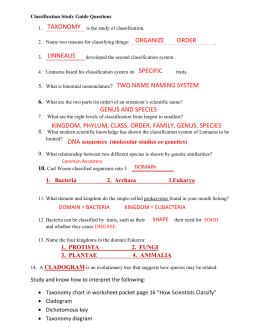Taxonomy Study Guide Answer Sheet
Taxonomy Handout for Classification of Living Things explains taxonomy (the classification of living things) in a simple and easy format that students can use as a study guide or reference sheet for their notebook. Includes a mnemonic device for remembering the order. Includes a study guide worksheet with some basic questions about the classification system, and a practice sheet with key. Great to start out the year and have this ready for back to school. Includes updated handout and study guide with Domain included in the taxonomy, and the three domains of archaea, eubacteria, and eukaryote.
- Read and Download PDF Ebook biological classification pogil answer key at Online Ebook Library. Classification study guide answers Taxonomy (Biology.
- 0 Up votes, mark as useful. 0 Down votes, mark as not useful. Classification Study Guide Answer Key.docx. Uploaded by hop2star. Use this to check your study guide we completed in class. Classification Study Guide Answer Key.docx. Know all vocabulary (classification, taxonomy, scientific name.
Classification Study Guide Answers

© HappyEdugator. For classroom and homeschool use.
EBooks Taxonomy Study Guide Answer Sheet is available in formats such as. PDF, DOC and ePUB which you can directly download and save in in to your.
Protista: unicellular, some multicellular, many found in water. Fungi: Multicellular EXCEPT FOR YEAST, digest food outside their body and then absorb it. Plantae: Multicellular, Autotrophic, absorbs sunlight to make glucose/photosynthesis 4. Animalia: Multicellular, Ingestive heterotrophs (means they eat food and digest it in their bodies), feed on plants and other animals. Eubacteria: eubacteria, or 'true bacteria' the most common bacteria today. Most living bacteria, including those that cause disease and decay, are eubacteria 6. Archaea: Archaea are a group of microscopic organisms that were discovered in the early 1970s.
Like bacteria, they are single-celled prokaryotes Archaeans were originally thought to be bacteria until DNA analysis showed that they are different. In fact, they are so different that the discovery prompted scientists to come up with a new system for classifying life.
